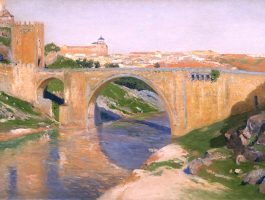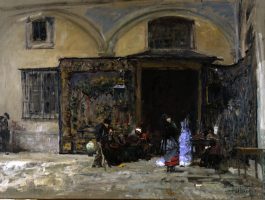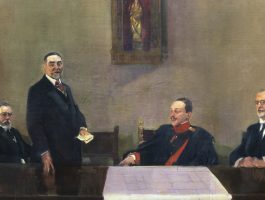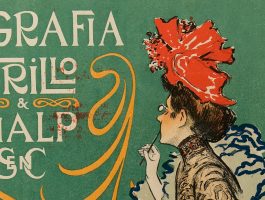
Audubon Terrace, the complex between 155th and 156th streets, Broadway and Riverside Drive, was conceived by Archer Milton Huntington as a cultural campus composed of learned societies and museums. It takes its name from the famous naturalist and artist John James Audubon (1785-1851) whose property originally spanned approximately 30 acres bounded by 155th and 158th streets, and the Hudson River to the west and Bloomindale Road to east, today Broadway. Audubon purchased the tract of land in 1841 after the completion of his great work The Birds of America (1827-38). From 1850 to 1910 the entire estate was known as Audubon Park. Huntington initially purchased eight lots for the Hispanic Society in 1904, and with the acquisition of an additional eight lots completed the present site of Audubon Terrace. Initially Huntington hoped to acquire all of the land from Broadway to the Hudson River between 155th and 156thstreets to construct a garden terrace on the slope to the river bank, but was deterred by the inflated real estate prices requested by the other land owners.
Following the completion of the Hispanic Society’s building in 1905, Huntington offered adjoining parcels to other cultural institutions with which he was associated and then subsidized the construction of their buildings in a uniform Beaux Arts/American Renaissance style. In the early years visitors reached the Museum and Library from 156th Street, passing through lofty iron gates, each decorated with the seal of the Hispanic Society, and then mounting terrace steps to the building. By 1910 Huntington’s cultural campus had begun to take shape with the addition of the American Numismatic Society and the American Geographical Society. To provide access from Broadway to the new institution, terraces were added and the property was renamed Audubon Terrace. The Main Building of the Hispanic Society, designed by Charles Pratt Huntington, was the first to be completed on the terrace in 1905, and the Museum and Library opened to the public in 1908. Subsequently, east and west wings were added in 1915 for the Sorolla Gallery and in 1921 for the Library Reading Room, and the North Building was opened in 1928.
Charles Pratt Huntington also designed the American Numismatic Society (1907), the American Geographical Society (1910), and the Museum of the American Indian-Heye Foundation (1916), as well as the Catholic Church of Nuestra Señora de la Esperanza (1912), with later alterations by the architecture firm of McKim, Meade & White. McKim, Meade & White also designed the American Academy of Arts and Letters (1923), although the subsequent addition was completed by Cass Gilbert (1930). The American Geographical Society, the Museum of the American Indian-Heye Foundation, and the American Numismatic Society subsequently relocated. Boricua College acquired the American Geographical Society building in 1980, the Museum of the American Indian-Heye Foundation building was purchased by the Hispanic Society in 1996, and the American Academy of Arts and Letters purchased the American Numismatic Society building in 2005. In addition to the impressive Beaux Arts/American Renaissance architecture, the terrace features a selection of sculptures by Anna Hyatt Huntington. From the beginning Huntington had intended to add sculpture to the buildings and to ensure their permanence by making them monumental works of art. Following his marriage to the sculptor Anna Vaughn Hyatt in 1923, plans for adding sculpture to Audubon Terrace began to take shape. Dominating the central space of the Hispanic Society’s lower terrace is the monumental bronze equestrian statue of El Cid Campeador. The first casting was presented by the Huntingtons to the city of Seville. The first replica was placed in the central court of the lower terrace on August 15, 1927. Four life-size bronze seated warriors leaning on shields were added to complete the ensemble. Additional sculptures by Anna Hyatt Huntington on the terrace include a red stag and red doe with fawn in bronze; two heraldic limestone lions with globes between their paws guard the entrance to the Museum and Library; and four limestone groups of bears, jaguars, vultures, and wild boars flank the top of the steps up to the terraces on each side of the North Building. Two monumental limestone equestrian sculpture reliefs on the façades of the North Building complete the sculptural program on the terrace: Boabdil, the last Nasrid king of Granada; and Don Quixote, whose crestfallen posture, broken staff, and gaunt horse Rocinante stand in stark contrast to El Cid’s vigorous stance and noble steed.




